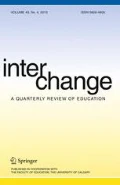References
Ayfre, A.Le cinéma et sa vérité. Paris: Editions du Cerf, 1968.
Bettelheim, B.Surviving. New York: Alfred A. Knopf, 1979.
Blakely, R. J.To serve the public interest: Educational broadcasting in the United States. Syracuse University Press, 1979.
Bruner, J.The process of education. Cambridge, Mass.: Harvard University Press, 1960.
Brunstetter, M. R.How to use the educational sound film. University of Chicago Press, 1937.
Cassidy, M. F. Toward integration: Education, instructional technology, and semiotics.Educational Communication and Technology Journal, Summer 1982,30 (2).
Chute, A. G. Effect of color and monochrome versions of a film on incidental and task-relevant learning.Educational Communication and Technology Journal Spring 1980,28 (1), 10–28.
Collins, D.Paolo Freire: His life, works, and thought. New York: Paulist Press, 1977.
Commission on Educational and Cultural Films.The film in national life. London: George, Allen & Unwin, 1932.
Culkin, J. M., & Schillaci, A. (Eds.).Films deliver. New York: Citation Press, 1970.
Dayton, D. K. Future trends in the production of instructional materials.Educational Communication and Technology Journal Winter 1981,29(4), 231–249.
Dewey, J.Democracy and education. New York: Macmillan, 1916.
Dewey, J.Experience and education. New York: Macmillan, 1939.
Eco, U. Can television teach?Screen Education, Summer 1979.
Ellis, D. C., & Thornborough, L.Motion pictures in education: A practical handbook for users of visual aids. New York: Crowell, 1923.
Freire, P.Pedagogy of the oppressed. New York: Herder & Herder, 1970.
Gibson, J. J.Motion picture testing and research. U.S. Air Force, 1946.
Goldman, F.Need Johnny read? Dayton, Ohio: Pflaum, 1971.
Goodman, N. When is art? In D. Perkins and B. Leondar (Eds.),The arts and cognition. Baltimore: Johns Hopkins University Press, 1977.
Heider, K.Ethnographic film. Austin: University of Texas Press, 1976.
Hirst, P. H., & Peters, R. S.The logic of education. New York: Humanities Press, 1970.
International Institute for Educational Planning.New educational media in action. Paris: UNESCO, 1967.
Karabel, J., & Halsey, A. (Eds.).Power and ideology in education. New York: Oxford University Press, 1977.
Katz, J.A curriculum in film. Toronto: The Ontario Institute for Studies in Education, 1972.
Latham, G. L.Means of spreading thought among the natives. Brussels: Etablissement Généraux D'Imprimerie, 1936.
May, M. & Lumsdaine, A.Learning from films. New Haven: Yale University Press, 1958.
Perkins, V. F. Form and discipline. In G. Mast and M. Cohen (Eds.),Film theory and criticism. New York: Oxford University Press, 1979.
Reisz, K., & Millar, G.Technique of film editing. New York: Hastings House, 1968.
Salomon, G.Interaction of media, cognition and learning. San Francisco: Jossey-Bass, 1979.
Singer, J. L. The powers and limitations of television. In P. Tannenbaum (Ed.),The entertainment function of television. Hillside, N.J.: Erlbaum, 1980.
Snow, R. E.The importance of selected audience and film characteristics as determiners of the effectiveness of instructional films. Lafayette, Ind.: U.S. Office of Education, 1963.
Snow, R. E., Tiffin, J., & Seibert, W. E. Individual differences and instructional film effects.Journal of Educational Psychology 1965,56(6), 315–326.
Soltis, J.An introduction to the analysis of educational concepts. Reading, Mass.: Addison-Wesley, 1968.
Sontag, S. The imagination of disaster. In Mast and Cohen (Eds.),Film theory and criticism. New York: Oxford University Press, 1979.
Thomas, R. M. The rise and decline of an educational technology: Television in American Samoa.Educational Communication and Technology Journal Fall 1980,28(3), 155–157.
Waller, W.The sociology of teaching. New York: John Wiley & Sons, 1932.
Author information
Authors and Affiliations
Rights and permissions
About this article
Cite this article
Nadaner, D. Toward an analysis of the educational value of film and television. Interchange 14, 43–55 (1983). https://doi.org/10.1007/BF01805817
Issue Date:
DOI: https://doi.org/10.1007/BF01805817

